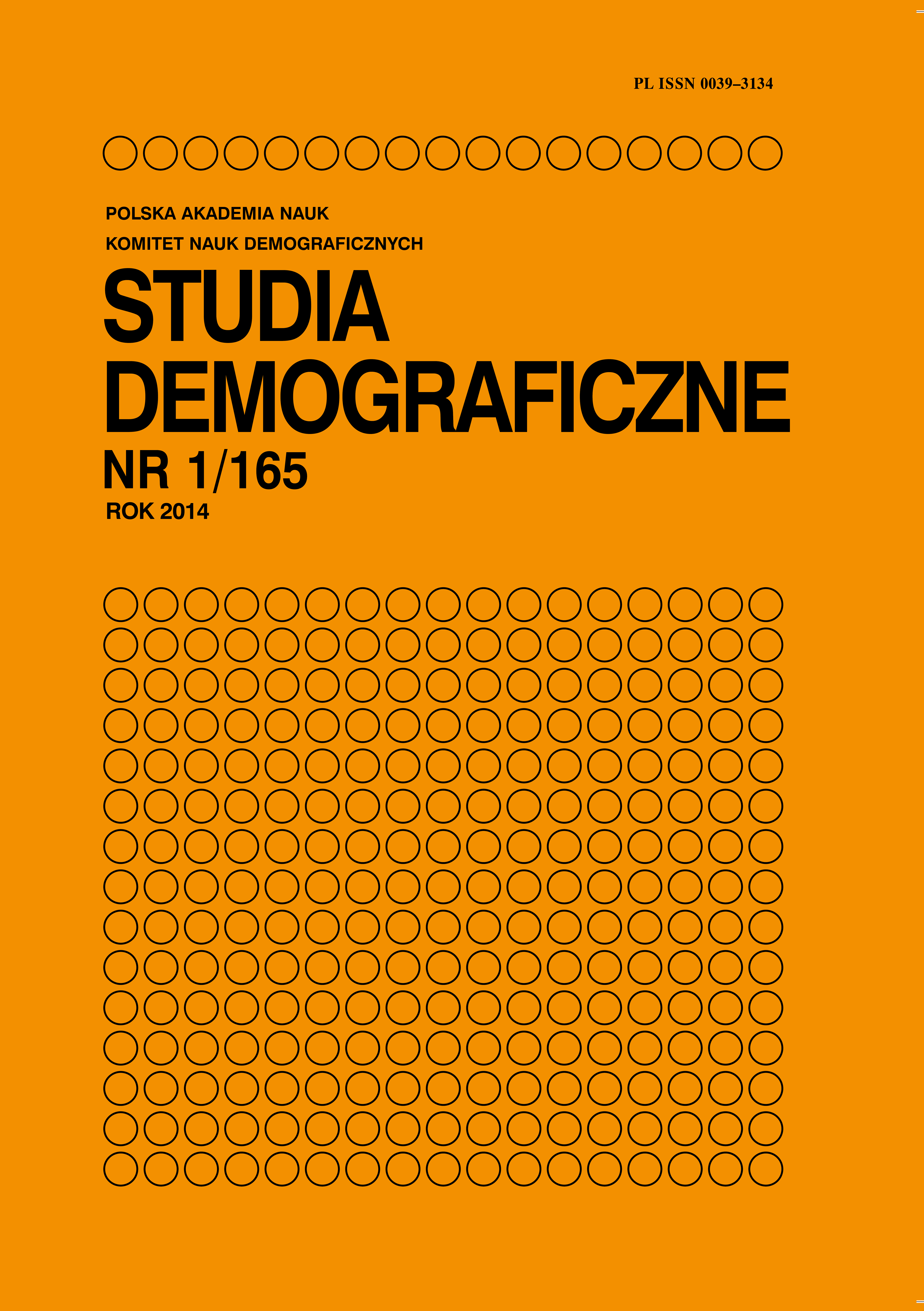Umieralność z przyczyn nieznanych i niedokładnie określonych oraz jej trwałe zróżnicowanie terytorialne w Polsce
Main Article Content
Abstract
An effective health policy can be only conducted on the basis of complete and up-to-date statistical data referring to, among others, causes of deaths. The share of deaths due to unknown and ill-defined causes constitutes one of quality indicators of data on mortality. As compared to other European countries, in Poland this share is relatively high, especially in some regions of the country. Presented analysis is devoted to spatial differences of mortality due to unknown and ill-defined causes in 1991–1995 and 2006–2010. Despite the introduction of the 10th revision of the International Statistical Classification of Diseases and Related Health Problems, as well as despite the modernization of data collecting system in 1997, spatial differences remained at a constant and moderate level, which probably results from the prevalence of local coding practices. We propose possible solutions that could contribute to decrease in share of death due to unknown and ill-defined causes in Poland, among them standardization of local coding procedures concerning causes of death.
Article Details
References
[2] Bijak J., 2003, Międzynarodowa porównywalność danych o zgonach według przyczyn w badaniu regionalnych różnic umieralności na przykładzie Czech, Holandii i Polski w latach 1994–1996, „Studia Demograficzne”, nr 2/144, 3–53.
[3] Brzozowska Z., 2011, Przestrzenne zróżnicowanie urodzeń pozamałżeńskich w Polsce w latach 2002–2010, „Studia Demograficzne”, nr 2/160, 59–83.
[4] Burton J., Underwood J., 2007, Clinical, educational, and epidemiological value of autopsy, „Lancet”, 369, s. 1471–1480.
[5] Eurostat, 2013, Statistics – Public Health, baza danych dostępna na stronie: http://epp.eurostat.ec.europa eu/
[6] Fihel A., 2011, Umieralność według pojedynczych przyczyn zgonu: rekonstrukcja danych dla Polski 1970–2009, „Studia Demograficzne”, nr 2/160, 3–33.
[7] Gatrell A. C., Elliott S. J., 2009, Geographies of health: An introduction, John Wiley & Sons.
[8] Gavrilova N., Semyonova V., Dubrovina E., Evdokushkina G., Ivanova A., Gavrilov L., 2008, Russian Mortality Crisis and the Quality of Vital Statistics, “Population Research and Policy Review”, 27, 5, 551–574.
[9] GUS, 2007, Final report within Project No 14, Improvement of statistics of causes of death, Transition Facility 2004 – 19100.2005.001–2005.536, raport niepublikowany, Warszawa.
[10] GUS, 2012, Rocznik Demograficzny 2012, Warszawa.
[11] GUS, 2013, Baza Demografia, baza danych dostępna na stronie: http://demografia.stat.gov.pl/bazademografia/Tables.aspx
[12] GUS, 2014, Na co umarł pacjent – czyli, co jest wpisywane na kartach zgonów?, GUS, Warszawa, dostępne na: http://stat.gov.pl/obszary-tematyczne/ludnosc/statystyka-przyczyn-zgonow/ (dostęp z dnia 20.05.2014).
[13] Human Mortality Database, 2013, University of California, Berkeley (USA), and Max Planck Institute for Demographic Research (Germany). Dostępne na stronie: http://www.mortality.org (dostęp z dnia 05.07.2013).
[14] Jędrychowski W., Mróz E., Wiernikowski A., Flak E., 2001, Trafność wyboru przez lekarza wyjściowej przyczyny zgonu i kodowania danych z kart zgonów, „Przegląd Epidemiologiczny”, 55, 3, 313–322.
[15] Kupść W., Piotrowski W., Kurjata B., Salaterski W., Broda G., Drygas W., 2008, Atlas umieralności spowodowanej chorobami układu krążenia w Polsce w latach 1997–2005, Instytut Kardiologii w Warszawie, Warszawa.
[16] Mathers C., Ma Fat D., Inoue M., Rao C., Lopez A., 2005, Counting the dead and what they died from: An assessment of the global status of cause of death data, „Bulletin of the World Health Organization”, 83, 171–177.
[17] Meslé F., 2002, The registration of causes of death: Problems of comparability, [w:] Wunsch G., Mouchart M., Duchene J. (eds.), The Life Table. Modelling Survival and Death (s. 171–190), European Studies of Population, EAPS, Kluwer Academic Publishers, Dordrecht.
[18] Meslé F., 2006, Medical Causes of Death, [w:] G. Caselli, J. Vallin, G. Wunch (red.), Demography. Analysis and Synthesis. A Treatise in Population Studies (s. 45–70, vol.2), Elsevier, Amsterdam, Boston.
[19] Mitchell A., 2005, The ESRI guide to GIS analysis, tom 2: Spatial Measurements and Statistics, ESRI, Redlands.
[20] Moran P.A.P., 1950, Notes on Continuous Stochastic Phenomena, „Biometrika”, nr 37, 17–23.
[21] Nolte E., Shkolnikov V., McKee M., 2000, Changing mortality patterns in East and West Germany and Poland II: short term trends during transition and in the 1990s, „Journal of Epidemiology and Community Health”, 54, 899–906.
[22] Pechholdová M., Fihel A., 2013, Understanding recent mortality reversal in Central Europe: case of Czech Republic and Poland, referat prezentowany na 27 Międzynarodowym Kongresie Ludnościowym w Busan, Korea Południowa, 26–31.08.2013.
[23] Susło R., 2011, Dokumentacja medyczna – uciążliwość czy ostatnia deska ratunku?, materiał z konferencji „Prawo a Medycyna” we Wrocławiu, dostępne też na stronie: http://www.prawoamedycyna.interpolska.pl/assets/Uploads/Prezentacje/Robert-Suslo-Dokumentacja-medyczna.pdf (data dostępu 20.07.2012).
[24] WHO, 2013, WHO methods and data sources for global causes of death, 2000–2011, WHO, Genewa. Wojtyniak B., Jankowski K., Zdrojewski T., Opolski G., 2012a, Regional differences in determining cardiovascular diseases as the cause of death in Poland: time for change, „Kardiologia Polska”, 70, 7, 695–701.
[25] Wojtyniak B., Rabczenko D., Pokarowski P., Poznańska A., Stokwiszewski J., 2012b, Atlas umieralności ludności Polski w latach 1999–2001 i 2008–2010, wydanie internetowe; http://www.atlas.pzh.gov.pl (data dostępu 9.03.2013).
[26] Zatoński W., Tyczyński J. (red.), 1999, Nowotwory złośliwe w Polsce w 1996 roku, Centrum Onkologii, Warszawa.
